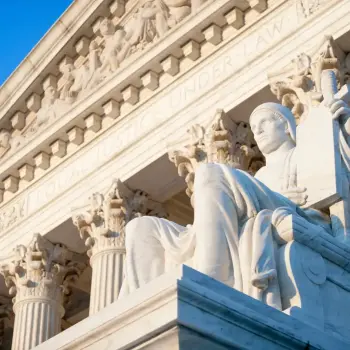Note: In the wake of the Southern Baptist Convention’s resolution regarding the use of in vitro fertilization (IVF), we have received numerous questions and concerns about how to understand that decision. Dr. Jim Denison will be addressing this subject in Monday’s Daily Article, but please see his article on IVF from earlier this year for more on what the Bible says on the subject and how we should approach it.
On Thursday, the Supreme Court ruled unanimously against a challenge that would have made it more difficult for people to receive the abortion drug mifepristone. The case was brought before the nation’s highest court in response to a ruling last year where a US district judge in Texas decided that the Food and Drug Administration (FDA) did not properly account for the additional risks and side effects caused by changes to how the drug was prescribed and administered. But before we get into what the decision means and where it might lead, let’s start by talking a bit more about mifepristone and why this case was so important.
Mifepristone is the first of two pills typically prescribed to women looking to end their pregnancy. It blocks progesterone, a hormone that—among other things—helps create a suitable environment for the child to grow and develop during pregnancy. As a result, the embryo stops growing and is then aborted when a second drug called misoprostol is taken a day or two later.
In the wake of Roe v. Wade’s reversal, the combination is now responsible for, conservatively, more than half of all abortions in the United States and three-quarters of abortions in Europe. As such, the case had the potential to make significant changes to the abortion landscape around the country.
But while their decision may be disappointing to those who believe life starts at conception, the reasoning behind the Court’s conclusion is important to consider.
Why the Court was right
The Supreme Court was clear before the case began that removing mifepristone from the market was not on the table, which provides important context to keep in mind when thinking about what could have happened if they ruled differently. Rather, they were considering changes to how the drug was obtained and administered, deciding instead that “the federal courts are the wrong forum for addressing the plaintiffs’ concerns about FDA’s actions.”
And, honestly, they’re right.
Moreover, that they reached that particular determination carries some potentially good news for the pro-life movement. You see, the Court’s decision was motivated by the conclusion that the plaintiffs didn’t have standing—the legal doctrine that requires them to show how they suffered direct and concrete injury—to bring the case. Essentially, it didn’t hurt them so they couldn’t sue.
That’s important because Justice Kavanaugh, who wrote the majority opinion, made clear that the reason they didn’t have standing is that none of the doctors or medical associations who brought the suit were forced to perform abortions or deal with any complications from them—the so-called conscience protections.
In so doing, he strongly intimated that should that ever cease to be the case, then the Court’s ruling on mifepristone would not apply. Moreover, it leaves open the possibility that a party who does have standing could bring a similar case before the Court in the future.
In short, no ruling was made on the merits or legality of mifepristone, and their verdict reinforced the importance of conscience protections going forward. Legally, that’s the correct conclusion, and it’s another example of the court’s decision to leave the issue of abortion up to the legislature and, most importantly, the individual.
That last part is what I’d like to focus on now.
Our approach doesn’t change
When states and courts make decisions that simplify the process of obtaining an abortion, it’s understandable and correct for us to lament that reality. Yet we must never forget that no matter what laws are passed or what verdicts are rendered, women will never be forced to get an abortion. It will remain their choice, which means we can help them choose life.
After all, very few women get an abortion because they want to. Rather, their decision is typically motivated by some combination of fear, finances, and the general circumstances of their lives. Those are all areas where we can and should help.
As such, even if Roe v. Wade is again made the law of the land and every restriction on abortion is lifted, our approach should not change.
Our job is to help people see the inherent value in all human life—both the child’s and the parents’—and to act accordingly.
We don’t need the government to do that. And, in some ways, the lack of legal restrictions simply reminds us of the need to get and stay involved in helping people understand and embrace the value of life.
We won’t change everyone’s minds, but if we ever reach the point where we’re placing more hope in our elected officials than in our ability to minister to the people around us, we’re headed down a dark path.
How God governs
Ultimately, our focus should be less on preventing people from having abortions and more on helping them to understand and embrace why the decision to end an unborn life is wrong.
God’s approach has always been aimed at changing people’s hearts and minds rather than just changing their behavior. Even in the theocratic moments of the Old Testament where God was recognized as Israel’s king, he rarely—if ever—handed down dictates that demanded obedience without also endeavoring to help his people understand why.
Our approach to the culture on this and every other moral issue needs to mirror his.
So while the temptation may be to view the Supreme Court’s decision as a loss, let’s instead use it as a reminder that our calling to stand for life with truth, love, and empathy remains unchanged and unaffected.
How can you live out that calling today?
Quote of the day:
“Not everyone with a sympathetic story is right. We can feel compassion for someone and protect them without fully agreeing with their behavior or perspective. Hopefully, others will show us the same grace when we’re wrong. Jesus modeled how to approach this reality perfectly.” — Justin Giboney

















